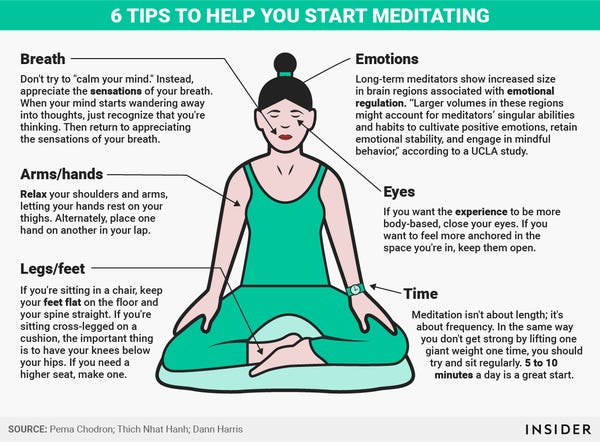
Meditation is a great way to help your kids. Meditation helps kids control their emotions and body. Children who learn meditation have more positive attitudes toward life, and can better regulate their emotions. Meditation improves attention, focus, organization, and coordination skills in children. They also sleep better, which is important for their growing minds. As a result, kids who learn meditation can lead happier, healthier lives. Here are some of the benefits of meditation for kids.
The best way to get your child into meditation is to have them follow your example. You can guide your child through meditation by using a visual example. Imagine your child seeing a picture with their best friend, sibling, or other family member. They can then imagine themselves in the same position as their pet. You can also use guided meditation for kids if your child isn't old enough to grasp the concept.

If your child is just starting out in meditation, you could also teach them the basics. Chanting is a simple technique you can try. Chanting can relax the mind and body. It allows students to integrate their hearing, speech, and breathing. Perhaps you want to offer your students a candle to burn while they meditate. Fire will relax your child's nervous system. They will be more focused on schoolwork and can relax with the help of fire. You must have fun teaching your child meditation.
Children meditation requires that you adapt mindfulness techniques and principles to your children. Children often have trouble understanding concepts and abstract concepts. Therefore, they are better served by activities that help them relax. In addition, you can include stories into the meditation routine for kids. This will help them calm down before going to bed, which is a great way to promote better sleep. You should include storytelling when teaching meditation to children. This will make the activity more engaging and fun.
Children who can focus on their breath are a good candidate to learn meditation. The exercise can be practiced with a parent. It's simple and enjoyable, and it will help them focus on their feelings. Children can also concentrate on the sounds and sensations around their bodies. For children who are still learning, it is possible to introduce them to kids meditation. The following tips can help you get started with children meditation.

The most important thing to remember when teaching kids to meditate is consistency. Kids will be able to learn about the benefits of meditation by being consistent. The environment they're in will help them switch into the state of mindfulness more easily, and they'll associate the time with relaxation. This will make it easier and more enjoyable for kids to meditate. They will also be more likely continue to practice it. You can also use it to entertain your family members and sing the song together.
FAQ
How do you measure body fat?
A Body Fat Analyzer can be used to measure body fat. These devices are used for measuring the percentage of body fat in people who want to lose weight.
What is the problem with BMI?
BMI is the acronym for Body Mass Index. It measures body fat based upon height and weight. Here is how to calculate BMI using the following formula.
Weight in kilograms divided with height in meters.
The result is expressed using a number from 0 through 25. A score of 18.5+ indicates that you are overweight. A score higher than 23 indicates that you are obese.
A person who weighs 100 kg and has a height of 1.75 m will have a BMI of 22.
These are the 7 secrets to a healthy life.
-
Make sure you eat right
-
Exercise regularly
-
Sleep well
-
Drink plenty of water.
-
Get enough rest
-
Be happy
-
Smile often
Are there 5 ways to have a healthy lifestyle?
Living a healthy lifestyle includes eating right, exercising regularly, getting enough sleep, managing stress, and having fun! Healthy eating means avoiding sugary and processed foods. Exercise is good for your body and muscles. Sleeping enough can improve memory and concentration. Stress management helps reduce anxiety and depression. Fun keeps us happy and healthy.
How often do I need to exercise?
Exercise is essential for maintaining a healthy lifestyle. However, there isn't a set amount of time you must spend working out. The key is finding something you enjoy and stick with it.
Three times a week, you should be aiming to complete 20-30 mins of moderate intensity activity. Moderate intensity means that you will still be working hard even after your workout is over. This type workout burns about 300 calories.
If you prefer to walk, go for 10 minute walks four days a week. Walking is low-impact and easy on the joints.
You can also run for 15 minutes, three times per week. Running is an excellent way to lose weight and tone your muscles.
Begin slowly if your are not used to working out. Start by doing 5 minutes of cardio each day, a few times per week. Gradually increase the time you do cardio until your goal is reached.
Exercise: Good or Bad for Immunity?
Exercise is good for your immune system. Your body makes white blood cells that fight infections when you exercise. Your body also eliminates toxins. Exercise helps prevent diseases like cancer and heart disease. It can also lower stress levels.
However, exercising too much can weaken your immune system. Your muscles can become sore if you exercise too much. This can cause inflammation and swelling. In order to fight infection, your body must produce more antibodies. Problem is, extra antibodies can trigger allergies and other autoimmune conditions.
So, don't overdo it!
What is the difference among a virus or a bacterium and what are their differences?
A virus, a microscopic organism, is incapable of reproducing outside its host cell. A bacterium, a single-celled organism, reproduces by splitting into two. Viruses are very small (about 20 nanometers) while bacteria are larger (up to 1 micron).
Viruses are often spread through contact of infected bodily fluids like saliva, urine or semen. Bacteria are often spread via direct contact with contaminated surfaces or objects.
Viruses may enter the body through cuts, scrapes. bites, or any other break in the skin. They can also penetrate the skin through the eyes, nose or mouth.
Bacteria may enter our bodies through cuts and scrapes on our skin, burns, insect bites, and other wounds. They can also be introduced to our bodies by food, water and soil.
Both bacteria and viruses can cause illness. But viruses can't multiply within their hosts. They can only infect living cells and cause illness.
Bacteria can spread within the host and cause illness. They can invade other areas of the body. We need antibiotics to get rid of them.
Statistics
- According to the 2020 Dietary Guidelines for Americans, a balanced diet high in fruits and vegetables, lean protein, low-fat dairy and whole grains is needed for optimal energy. (mayoclinichealthsystem.org)
- This article received 11 testimonials and 86% of readers who voted found it helpful, earning it our reader-approved status. (wikihow.com)
- In both adults and children, the intake of free sugars should be reduced to less than 10% of total energy intake. (who.int)
- The Dietary Guidelines for Americans recommend keeping added sugar intake below 10% of your daily calorie intake, while the World Health Organization recommends slashing added sugars to 5% or less of your daily calories for optimal health (59Trusted (healthline.com)
External Links
How To
What does the word "vitamin" mean?
Vitamins are organic substances found naturally in food. Vitamins help us absorb nutrients from foods we eat. The body cannot make vitamins; therefore, they must be obtained from food.
Two types of vitamins exist: water-soluble vitamin and fat-soluble vitamin. Water soluble vitamins dissolve easily in water. Examples include vitamin C,B1 (thiamine), B2 (riboflavin), B3 (niacin), B6 (pyridoxine), folic acid, biotin, pantothenic acid, and choline. Fat soluble vitamins are stored in the liver and fatty tissue. Examples include vitamin D, E, K, A, and beta carotene.
Vitamins can be classified according to biological activity. There are eight main groups of vitamins.
-
A - Vital for normal growth and maintaining good health.
-
C - essential for nerve function and energy generation.
-
D - Essential for healthy teeth and bones.
-
E is needed for good reproduction and vision.
-
K - essential for healthy muscles, nerves, and bones.
-
P - vital for building strong bones andteeth.
-
Q – aids digestion of iron and iron absorption
-
R - Red blood cells are made from red blood cells.
The recommended daily allowance (RDA), for vitamins, varies depending upon age, gender, or physical condition. The U.S. Food and Drug Administration has established the RDA values.
For adults over 19, the RDA for vitaminA is 400 micrograms per daily. Pregnant mothers need 600 micrograms per days because it is vital for the development and growth of their baby. Children ages 1-8 require 900 micrograms per day. Infants under one year of age require 700 micrograms per day, but this amount decreases to 500 micrograms per day between 9 months and 12 months of age.
Children between the ages of 1-18 need 800 micrograms per daily for obesity, while children overweight require 1000 micrograms. Children underweight or obese will need 1200 mg per day.
Children between 4 and 8 years old with anemia will need 2200 micrograms daily of vitamin C.
2000 micrograms per person is necessary for general health. Women who are pregnant or breastfeeding need 3000 micrograms per day due to increased nutrient requirements.
1500 micrograms is the recommended daily intake for adults aged 70+, who lose approximately 10% of muscle each year.
Women who are pregnant or lactating need more than the RDA. Pregnant and breastfeeding women require 4000 micrograms each day during pregnancy and 2500 Micrograms each day after delivery. Breastfeeding mothers require 5000 micrograms daily when breast milk production is occurring.